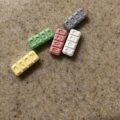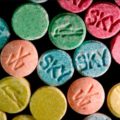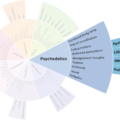The term “candy flip” might evoke a sense of curiosity or intrigue for those familiar with it, while others may have never heard of this particular term. Candy flipping is a slang phrase used within the realm of recreational drug use to describe the simultaneous ingestion of two potent psychoactive substances: MDMA (3,4-methylenedioxymethamphetamine), commonly known as ecstasy, and LSD (lysergic acid diethylamide), often referred to as acid.
This unique combination produces an intense and profound psychedelic experience, which has gained popularity among some individuals who seek altered states of consciousness. In this article, we will delve into the world of candy flipping, exploring the effects, risks, cultural aspects, and the broader context of psychedelic experiences.
The Dance of Two Powerful Psychedelics
Candy flipping is not a new phenomenon; it has been around for several decades, although it has gained more recognition in recent years as conversations about psychedelics have become less taboo. The term itself, “candy flip,” is a fusion of the words “candy” (a reference to MDMA’s association with club culture and its sometimes candy-like appearance) and “flip” (slang for taking multiple drugs in combination).
MDMA: The Ecstasy of Connection
MDMA, also known as ecstasy, is renowned for its empathogenic and entactogenic effects. When ingested, it primarily acts as a stimulant and releases a surge of serotonin, dopamine, and norepinephrine in the brain. Users often experience a heightened sense of empathy, emotional closeness, and a desire to connect with others. The effects can include enhanced sociability, sensory perception, and feelings of love and euphoria.
LSD: The Acid Trip to the Unknown
LSD, on the other hand, is a classical psychedelic that alters perception, thinking, and consciousness. It works by affecting serotonin receptors, but its precise mechanisms are still a subject of scientific inquiry. LSD is known for inducing profound, altered states of consciousness, often leading to intense visual and auditory hallucinations, a distorted sense of time, and deep introspection. Users may encounter a wide array of sensory experiences and altered thoughts, often described as a journey into the depths of the mind.
The Chemistry of Candy Flipping
Candy flipping combines two substances with distinct mechanisms of action. While both MDMA and LSD affect serotonin in some way, they have divergent effects and can interact in complex ways when taken together. Understanding the chemistry of this combination is vital to grasp the potential experiences and risks.
- Synergistic Effects
When MDMA and LSD are ingested together, they can produce a combination of effects that can be experienced as greater than the sum of their individual parts. The empathogenic and loving effects of MDMA may enhance the already deep emotional and introspective experiences of LSD. Users may report heightened emotional sensitivity and the ability to confront and process deep-seated issues.
- Extended Duration
LSD trips are known for their lengthy duration, often lasting 8 to 12 hours or more. When combined with MDMA, the duration of the experience may be extended due to the stimulating effects of MDMA, which can prolong the intensity of the LSD trip. This extended duration can be both a blessing and a challenge, as it allows for a more profound exploration of consciousness but also necessitates more careful planning.
- Risks of Overstimulation
One of the primary concerns with candy flipping is the risk of overstimulation. Both MDMA and LSD can increase heart rate and body temperature. When combined, the stimulating effects may be amplified, potentially leading to dehydration, overheating, and cardiovascular strain. It is crucial for users to remain well-hydrated and avoid excessive physical activity during the experience.
The Psychedelic Experience
Candy flipping is not for the inexperienced or the faint of heart. It is an intense and often overwhelming journey into altered states of consciousness. The experience can vary widely from person to person, influenced by factors such as dose, individual tolerance, setting, and mindset.
- The Come-Up
The onset of a candy flip can be a rollercoaster of sensations. As both substances begin to take effect, users may feel waves of euphoria and intense energy. The body and mind become highly sensitive, and the world may appear in a new, vivid light.
- Emotional Intensity
A defining feature of candy flipping is the emotional intensity. Users often report profound feelings of love, connection, and empathy. This can lead to intense bonding experiences with friends or even strangers.
- Visual and Auditory Hallucinations
The LSD component of the experience brings vivid visual and auditory hallucinations. These can range from intricate geometric patterns to a complete distortion of one’s perception of reality. Users may “see” music or “hear” colors.
- Introspection and Self-Reflection
The introspective quality of the LSD experience is heightened by the emotional openness facilitated by MDMA. Users often find themselves exploring their own thoughts, feelings, and memories in a deeply meaningful way. Insights and self-reflection are common.
- Challenges and Difficult Moments
Despite the potential for beautiful and insightful experiences, candy flipping can also lead to challenging and difficult moments. The intense nature of the trip can make it hard to navigate moments of fear, confusion, or existential questioning. It’s essential to have a trusted and experienced trip sitter to help guide users through these challenging phases.
Risks and Precautions
As with any powerful psychoactive experience, there are inherent risks associated with candy flipping. It is not a decision to be taken lightly, and users should be aware of the potential risks and take precautions to ensure their safety.
- Physical Risks
The combined stimulant effects of MDMA and LSD can put a strain on the cardiovascular system, leading to increased heart rate and blood pressure. This can be particularly concerning for individuals with pre-existing heart conditions. Users should monitor their physical condition and stay hydrated.
- Mental Health Considerations
Candy flipping can intensify emotional experiences and bring buried feelings to the surface. For individuals with a history of mental health issues, this can be challenging. Those with a personal or family history of psychosis should exercise caution, as psychedelics can trigger or exacerbate psychotic episodes.
- Set and Setting
The importance of set and setting cannot be overstated. Users should plan their candy flipping experience carefully, ensuring they are in a safe and supportive environment, both physically and mentally. A trusted trip sitter can be invaluable.
- Dosage and Purity
The purity and dosage of the substances used are critical. Impure or adulterated substances can increase the risks of adverse effects. It is advisable to test the substances to ensure purity and start with a lower dose, especially for those new to the combination.
- Integration
The experiences encountered during candy flipping can be profound and impactful. It’s essential to plan for integration after the experience, allowing time for reflection and understanding of the insights gained.
The Broader Context of Psychedelic Experiences
Candy flipping is just one example of the myriad ways in which people explore altered states of consciousness through psychedelic substances. Psychedelics have a long history of use in various cultures for spiritual, therapeutic, and personal growth purposes.
- Therapeutic Potential
Recent scientific research has been exploring the therapeutic potential of psychedelics, including MDMA and LSD, for conditions such as post-traumatic stress disorder (PTSD), depression, and anxiety. Studies have shown promising results, and these substances are being considered for future therapeutic applications. The combination of MDMA and LSD in a controlled therapeutic setting may offer unique insights into the human psyche and emotional healing, but it remains a subject of ongoing research.
- The Importance of Responsible Use
Responsible use of psychedelics is essential. People who choose to explore these substances should do so with a full understanding of the potential risks and benefits. Harm reduction measures, such as testing substances for purity and strength, practicing safe dosing, and having a trusted and experienced sitter, are vital for ensuring a positive and safe experience.
- Cultural and Societal Shifts
In recent years, there has been a significant cultural and societal shift in the perception of psychedelics. The taboo surrounding these substances has lessened, and conversations about their potential benefits have become more open. Initiatives to decriminalize or legalize psychedelics for therapeutic use are gaining traction in some places. However, it is crucial that this shift is accompanied by responsible education and regulation to minimize potential harms.
Conclusion
Candy flipping is a potent and often intense psychedelic experience that combines the effects of MDMA and LSD. It can lead to profound insights, emotional experiences, and visual hallucinations. However, it also carries inherent risks, including physical and mental health considerations. Responsible use, preparation, and harm reduction measures are essential when exploring this combination.
The world of psychedelics is evolving, and their potential therapeutic applications are being explored in clinical settings. While candy flipping remains largely a recreational pursuit, it highlights the complexity and depth of human consciousness and the human drive to explore altered states. As we move forward, understanding, respect, and responsible use are critical to ensure that these powerful substances are used safely and for the betterment of individuals and society as a whole.





